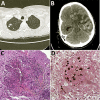Invasive Infections Caused by Nannizziopsis spp. Molds in Immunocompromised Patients
- PMID: 29460742
- PMCID: PMC5823334
- DOI: 10.3201/eid2403.170772
Invasive Infections Caused by Nannizziopsis spp. Molds in Immunocompromised Patients
Abstract
We report 2 new cases of invasive infections caused by Nannizziopsis spp. molds in France. Both patients had cerebral abscesses and were immunocompromised. Both patients had recently spent time in Africa.
Keywords: Nannizziopsis; central nervous system fungal infection; emerging disease; fungi; immunocompromised patients; invasive fungal infection; molds; opportunistic fungal pathogen.
Figures

References
-
- Stillwell WT, Rubin BD, Axelrod JL. Chrysosporium, a new causative agent in osteomyelitis. A case report. Clin Orthop Relat Res. 1984; (184):190–2. - PubMed
-
- Sigler L, Hambleton S, Paré JA. Molecular characterization of reptile pathogens currently known as members of the chrysosporium anamorph of Nannizziopsis vriesii complex and relationship with some human-associated isolates. J Clin Microbiol. 2013;51:3338–57. 10.1128/JCM.01465-13 - DOI - PMC - PubMed
Publication types
MeSH terms
Substances
LinkOut - more resources
Full Text Sources
Other Literature Sources
Molecular Biology Databases
Miscellaneous

